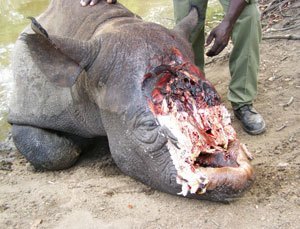
YESTERDAY was World Rhino Day and Zimbabwe, like the rest of the world, joined in the celebrations.
Report by Chipo Masara As much as it is commendable that we should recognise the day, the rhinoceros is under threat and there is need for serious reflection on the matter.
The small-eyed, three-toed, mud-rolling mammal characterised by a broad chest, thick legs and a great sense of hearing, used to be at home in Zimbabwe. Not anymore.
The rhino, the second biggest land mammal, is endangered and faces an uncertain future. Like South Africa, Zimbabwe’s battle with poachers seems to be escalating, with the rhinoceros proving to be their number one target.
Although Zimbabwe Parks and Wildlife Management Authority have been continually putting in place measures designed to make it very hard for the poachers to get to the animals, so far it does not look like it has been enough to deter the poachers.
The poachers appear to have upped their game and are getting more well-organised by the day. Their activities prompted the authority’s late director-general, Vitalis Chadenga, to admit that rhino tusks were being removed “quickly, clinically and professionally”.
What has become apparent is that rhino poaching has become a well-funded, highly profitable trade and the demand for illegal rhino horn has surged.
- Chamisa under fire over US$120K donation
- Mavhunga puts DeMbare into Chibuku quarterfinals
- Pension funds bet on Cabora Bassa oilfields
- Councils defy govt fire tender directive
Keep Reading
China blamed for promoting poaching
In 2008, at a workshop organised by the Global Association for People and the Environment (Gape) and the International Fund for Animal Welfare (Ifaw), Yemen and China were accused of fuelling rhino poaching in Africa.
A year later, the Convention on International Trade in Endangered Species (Cites)’s report noted: “Currently, most rhino horns leaving southern Africa are destined for end-use markets in southeast and east Asia, especially Vietnam and China.”
It added: “The continued involvement of Vietnamese and Chinese nationals in the acquisition of rhino horns within Africa needs to be addressed from the standpoints of collective and collaborative law enforcement action involving authorities both in Africa and Asia.”
Sadly, the rhino poaching problem has not ended but has grown to alarming levels, making the threat of the rhinoceros extinction more real than before.
In Yemen, rhino horns are in demand and are used to make ornamental handles for ceremonial jambiyas (daggers). in China, they have been used in traditional medicines for centuries.
As the animals’ numbers continually decline, the horns are reportedly in demand more than ever, as the Chinese continue to consider them a cure for basically “everything”.
This is however in spite of the fact that scientific evidence has since proven that rhino does not, in actual fact, contain any medicinal properties.
Unfortunately, the Chinese have such belief in their myths that they are reportedly prepared to part with as much as US$60 000 for one kilogramme of rhino horn.
Considering this, what is left of the rhino in the country is very much a target of the poachers, and unless stricter, harsher measures are immediately put in place, we risk losing them all.
‘Parks authority intensifying measures to protect rhinos’
Caroline Washaya-Moyo, Zimbabwe Parks and Wildlife Management Authority spokesperson, said her organisation had stepped up efforts to protect the rhino by creating intensive protection zones (IPZ) for the animals and intensifying anti-poaching activities.
“Zimbabwe has just over 700, both black and white, rhinos left and to date we have lost 17 rhinos,” said Washaya-Moyo.
While these figures show that poaching might be on the decline, it is worrying to note that at independence in 1980, the country boasted of 2 000 black rhinos.
Although poaching is undoubtedly the main threat, habitat loss has also posed as a major impediment to the animals’ thriving. The wildlife sanctuaries in the country have since been invaded under what has been termed the wildlife-based land reform programme, an exercise that exposes the animals to poachers.
Extensive logging, both legal and illegal, has also created a problem. Political instability in the country has not made the situation any better. Zimbabwe is ranked among the countries in which normal law and order has broken down, with political conflict having been matched by a rise in poaching.
In attempts to save the fast-depleting species, government introduced a dehorning policy. This method however has been viewed by some as not only ineffective, but cruel. There have been cases where the dehorned rhinos have still been killed by poachers.
So while we “celebrate” World Rhino Day, it is good that we reflect on the fate that befalls the animal, which happens to be one of the Big Five.
The truth of the matter is that if nothing is done to make things right, rhinoceros in Zimbabwe will one day be nothing but a memory.











